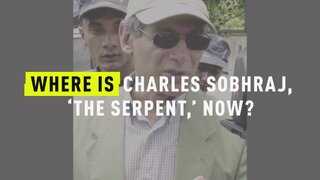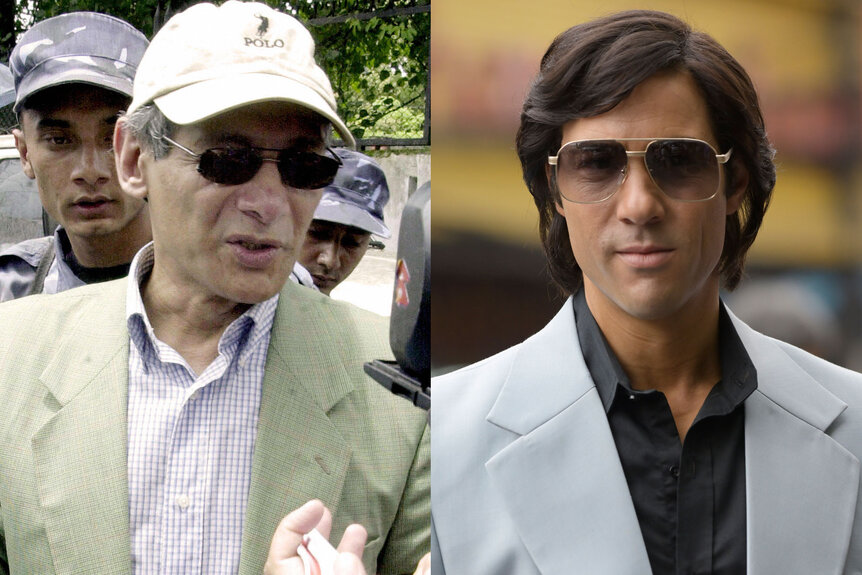Create a free profile to get unlimited access to exclusive videos, breaking news, sweepstakes, and more!
Where Is Charles Sobhraj, 'The Serpent,' Now?
Charles Sobhraj, whose 1970s killing spree largely targeting tourists in Asia is depicted in "The Serpent," escaped prison at least four times, but he's currently safely behind bars in Nepal.

Charles Sobhraj, the French killer and con artist believed responsible for the murders of at least 12 people across Asia during the 1970s, made a habit of evading justice, employing a slippery and dangerous nature to escape from prison on numerous occasions. It's no wonder he became known as "The Serpent."
Sobhraj's story is the subject of the an eight-part BBC docudrama "The Serpent," now available on Netflix.
Sobhraj (portrayed by Tahar Rahim) and his girlfriend and accomplice Marie-Andrée Leclerc (Jenna Coleman), a French Canadian, would pose as gem dealers while traveling through Thailand, Nepal and India along stretches known as the ‘Hippie Trail,” which extended from Europe into South Asia and were popular among globetrotting beatniks and hippies from the 1950s through the late '70s.
They’d target Western tourists — primarily European and American backpackers — whom they would drug, rob and, in some cases, kill. In addition to money, Sobhraj, who was born in Vietnam but had French citizenship, would also steal victims’ passports for his own use. The first episode of the BBC series depicts the murder of his first known tourist victim Teresa Knowlton, a 21-year-old American backpacker who met Sobhraj in Bangkok, Thailand in 1975. Knowlton turned up dead in the Gulf of Thailand in October of that year, clad in a bikini (the attire of some of Sobhraj's alleged victims also earned him the name "The Bikini Killer"). Days after her body was found, Leclerc cashed Knowlton's traveler's checks, according to The Independent, and authorities, who assumed she drowned, never connected Sobhraj or Leclerc to her death. The series, based in part on the book "The Life and Crimes of Charles Sobhraj" by Australian journalists Richard Neville and Julie Clarke, who spent dozens of hours interviewing Sobhraj in prison in 1977, depicts Sobhraj killing Knowlton and disposing of her body with the help of alleged accomplice Ajay Chowdhury.
Investigators have estimated that Sobhraj killed between 12 and 20 people, The Los Angeles Times reports. In his interviews with Neville and Clark, he initially admitted to at least 12 killings between 1972 and 1976, though he later recanted, CNN reports. He claimed to have committed his first murder in 1972 by killing a taxi driver while in Pakistan. While he was never charged with the murder, he was behind bars in various countries at least five times for lower level offenses before he was officially suspected of murder. He also escaped jail at least four times, according to CNN. He escaped an Afghanistan jail for robbery by faking illness and drugging guards in 1972. He escaped an India prison a year later by again faking illness. Then, in 1975, he escaped incarceration by setting fire to a prison van.
His first murder charge came in 1976 when Sobhraj was caught in New Delhi drugging students, according to the Los Angeles Times. He was charged with both robbery and the murders of an Israeli man, Alan Aaron Jacobs, in Varanasi and a French tourist in New Delhi. He was found guilty of both robbery and murder, but the murder convictions were later overturned on appeal. He was incarcerated from 1976 to 1997, during which time he was apparently treated like royalty. He was given multiple cells and privileges, according to journalist Alan Dawson, who interviewed Sobhraj in 1984. He also managed to briefly escape prison again in 1986 by drugging guards with laced fruit, claiming it was his birthday.
After his release in 1997, he moved to Paris and regularly did interviews with the media, apparently smug in his freedom. But that didn't last long. While visiting Kathmandu, Nepal — the only country where there was still an outstanding warrant for his arrest — in 2003, he was arrested on suspicion of the 1975 murder of American tourist Connie Jo Bronzich. He was convicted and sentenced to life a year later and has undertaken several unsuccessful appeals.
The United Nations Human Rights Committee argued in 2010 that he hadn’t received a fair trial, Esquire reported earlier this year. But, four years later, he was found guilty of another murder: the killing of Connie Jo’s partner Laurent Carriere. He was given a second life sentence and remains behind bars in Kathmandu. He is 77.
Meanwhile, Leclerc died of cancer at age 38 while still proclaiming her innocence. She was jailed for conspiring to murder Jacobs, the Israeli tourist, in India but she was released to seek medical treatment before dying, UPI reported in 1983. Chowdhury was last seen in 1976.
Sobhraj married Nihita Biswas in 2008 while he was behind bars. While the docudrama is based in part on Clarke and Neville's previous interviews with the suspected serial killer, the makers of “The Serpent” did not interview him themselves.
“We chose not to speak to him,” Paul Testar, producer, told the Los Angeles Times. “Julie and her husband, Richard, spent hours and hours and hours in prison interviewing Sobhraj and taping them. Julie gave us access to those tapes, which meant we could hear Sobhraj’s account of that period without having to engage with him directly. It felt like the only use of engaging with Sobhraj directly was to see how he’d lie to you and to see how he’d try to pull the wool over you. We were able to listen to those tapes from a more objective standpoint.”



























